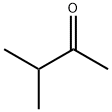Other grades of this product :
| 3-Methyl-2-butanone Basic information |
| 3-Methyl-2-butanone Chemical Properties |
| Melting point | -92 °C (lit.) | | Boiling point | 94-95 °C (lit.) | | density | 0.805 g/mL at 25 °C (lit.) | | vapor pressure | 53.33 hPa (19.9 °C) | | refractive index | n20/D 1.388(lit.) | | Fp | 6 °C | | storage temp. | Store below +30°C. | | solubility | water: soluble8.21g/L at 20°C | | form | Liquid | | color | Clear colorless | | Odor Threshold | 0.5ppm | | explosive limit | 1.5-9%(V) | | Water Solubility | 6 g/L (20 ºC) | | Merck | 14,6090 | | BRN | 1071238 | | Exposure limits | TLV-TWA 700 mg/m3 (200 ppm); STEL
875 mg/m3 (250 ppm) (ACGIH). | | InChIKey | SYBYTAAJFKOIEJ-UHFFFAOYSA-N | | LogP | 2.29 at 20℃ | | CAS DataBase Reference | 563-80-4(CAS DataBase Reference) | | NIST Chemistry Reference | 2-Butanone, 3-methyl-(563-80-4) | | EPA Substance Registry System | Methyl isopropyl ketone (563-80-4) |
| Hazard Codes | F | | Risk Statements | 11-67 | | Safety Statements | 9-16-33 | | RIDADR | UN 2397 3/PG 2 | | WGK Germany | 1 | | RTECS | EL9100000 | | Autoignition Temperature | 475 °C | | Hazard Note | Highly Flammable | | TSCA | Yes | | HazardClass | 3 | | PackingGroup | II | | HS Code | 29141990 | | Hazardous Substances Data | 563-80-4(Hazardous Substances Data) | | Toxicity | LD50 orally in male mice: 29.86 mmol/kg (Tanii) |
| 3-Methyl-2-butanone Usage And Synthesis |
| Chemical Properties | CLEAR COLOURLESS LIQUID | | Chemical Properties | MIPK is a colorless liquid with an acetonelike odor. | | Uses | Methyl isopropyl ketone (MIPK) is used asa solvent for lacquers. | | Uses | 3-Methyl-2-butanone is used for synthesis of heterocyclic compounds and important intermediate of medicine. It is used as an industrial solvent. | | Uses | Solvent for nitrocellulose lacquers. | | General Description | A colorless liquid with a pleasant odor. Flash point below 70°F. Less dense than water. May be toxic by inhalation and skin absorption. Used as a solvent. | | Air & Water Reactions | Highly flammable. Soluble in water. | | Reactivity Profile | Ketones, such as 3-Methyl-2-butanone, are reactive with many acids and bases liberating heat and flammable gases (e.g., H2). The amount of heat may be sufficient to start a fire in the unreacted portion of the ketone. Ketones react with reducing agents such as hydrides, alkali metals, and nitrides to produce flammable gas (H2) and heat. Ketones are incompatible with isocyanates, aldehydes, cyanides, peroxides, and anhydrides. They react violently with aldehydes, HNO3, HNO3 + H2O2, and HClO4. | | Hazard | Toxic material. Embryo/fetal damage andneonatal toxicity. | | Health Hazard | Irritating to the eyes, nose, throat, upper respiratory tract, and skin. | | Health Hazard | The acute toxic effects from exposure to thevapors of MIPK are narcosis and irritationof the eyes, skin, and respiratory passages.In rabbits the irritation effect of 100 mg fora 24-hour exposure was mild in the eyes,while 500 mg was moderate on the skin. Thetoxicity data on this compound are too scant.In general, its toxicity is low and narcosissymptoms in humans may be felt only at veryhigh concentrations. In guinea pigs exposureto 5000 ppm caused coma. | | Fire Hazard | Special Hazards of Combustion Products: Acrid smoke and fumes | | Flammability and Explosibility | Highlyflammable | | Safety Profile | Poison by ingestion.
Mildly toxic by inhalation and skin contact.
Mutation data reported. A skin and eye
irritant. Flammable when exposed to heat or
flame; can react vigorously with oxidizing
materials. When heated to decomposition it
emits acrid smoke and irritating fumes. | | Potential Exposure | This ketone is used as a solvent for
nitrocellulose lacquers. | | Shipping | UN23973-Methylbutan-2-one, Hazard Class: 3;
Labels: 3-Flammable liquid. | | Purification Methods | Reflux the ketone with a little KMnO4. Fractionate it through a spinning-band column, dry with CaSO4 and distil it. [Beilstein 1 IV 3287.] | | Incompatibilities | Vapors may form explosive mixture with
air. Ketones are incompatible with oxidizers (chlorates,
nitrates, peroxides, permanganates, perchlorates, chlorine,
bromine, fluorine, etc.); contact may cause fires or explosions. Keep away from alkaline materials, strong bases,
strong acids, oxoacids, epoxides, nitrated amines, azo,
diazo, azido compounds, carbamates, organic cyanates | | Waste Disposal | Dissolve or mix the material
with a combustible solvent and burn in a chemical incinerator equipped with an afterburner and scrubber. All
federal, state, and local environmental regulations must
be observed. |
| 3-Methyl-2-butanone Preparation Products And Raw materials |
| Raw materials | Oxygen-->Isobutyraldehyde-->2-Methyl-2-butanol-->2,3-dibromo-2-methylbutane-->DL-Mevalonolactone-->Dehydromevalonolactone-->Isoprene | | Preparation Products | Imazaquin acid-->1,3,3-TRIMETHYLINDOLINOBENZOPYRYLOSPIRAN-->2,6-DIMETHYL-3,5-HEPTANEDIONE-->1,2,5-OXADIAZOLE-3-CARBOXYLIC ACID-->3-METHYL-1,2,5-OXADIAZOLE-->(1,2-DIMETHYL-PROPYL)-HYDRAZINE-->Imazamox-->Bromoform-->2-Amino-2,3-dimethylbutyronitrile-->2-Butanone, 3-methyl-, oxime-->Ethyl isobutyrylacetate-->N-AMYL ISOPROPYL KETONE-->2,3-DIMETHYLDECANE-->2,3,3-Trimethyl-5-methoxy-3H-indole |
|
